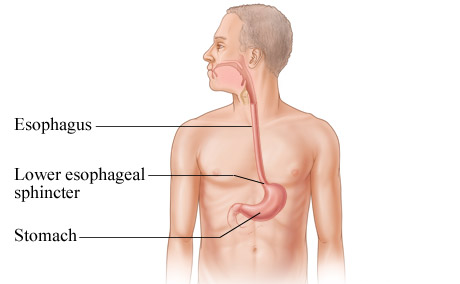16 Jan My Teenager Complains of Difficulty Swallowing
 There are many reasons a child may complain of difficulty swallowing such as Gastroesophageal Reflux Disease or Eosinophilic Disease. A less common reason for difficulty swallowing but a possible cause to consider is Achalasia.
There are many reasons a child may complain of difficulty swallowing such as Gastroesophageal Reflux Disease or Eosinophilic Disease. A less common reason for difficulty swallowing but a possible cause to consider is Achalasia.
What is Achalasia?
Achalasia means “failure to relax” and refers to the inability of the muscle between the lower part of the esophagus (feeding tube) and stomach to open and allow food to pass. 
The lower part of the esophagus, just before the stomach, is called the lower esophageal sphincter. The lower esophageal sphincter normally remains closed so food and acid does not reflux back up into the esophagus from the stomach. When swallowing food and liquid, the normal contractions of the esophagus allow the lower esophageal sphincter to relax and open to allow the food and liquid to enter the stomach. In achalasia, the resting pressure of the lower esophageal sphincter is abnormally high because of degeneration and loss of nerve cells and therefore the lower esophageal sphincter is unable to relax to allow food and liquid to pass.
What Symptoms do Children with Achalasia Complain About?
Achalasia can be a slow and progressive disorder. As time passes, children may complain of symptoms that include:
- Difficulty swallowing solids
- Difficulty swallowing liquids
- Burning or pain in the chest
- Regurgitation of food into the mouth
- Feeling of food getting stuck after swallowing
- Sensation of a lump in the throat
- Vomiting
- Loss of weight
- Coughing
What causes Achalasia?
The exact cause of achalasia remains unknown. However, possible reasons the nerve cells degenerate include:
- Infection
- Autoimmune
- Hereditary
How is Achalasia Diagnosed in Children?
The diagnosis of achalasia is made by performing esophageal manometry. Esophageal manometry is a very specialized test that measures the pressure in the lower esophageal sphincter. Esophageal manometry also measures the rhythm and coordination of muscle contractions in the esophagus during swallowing. During this test, a thin tube is placed through the nose into the esophagus to evaluate your child’s esophagus.
Other tests that may be ordered to see if esophageal manometry is needed include:
Upper GI series: The child swallows barium (a white, chalky liquid) and a video x-ray machine tracks the barium through the esophagus, stomach, and upper intestinal tract to detect any obstructions, abnormalities, or narrowing.
Upper GI endoscopy: An ultra-thin, flexible tube equipped with lights and camera is inserted through the mouth into the esophagus, stomach, and upper part of the small intestine allowing the doctor to see any inflammation or irritation.
What is the Treatment for Achalasia?
The treatment of achalasia involves relieving the obstruction that is being caused by the inability of the lower esophageal sphincter to relax. Based on the child’s symptoms and test results, options including dilation and surgery. Medication alone is not an effective treatment.
If your child has difficulty swallowing or other symptoms of achalasia, then speak to your child’s physician about your concerns.
If you would like more information about gastrointestinal (GI) digestive disorders and nutrition in children, please contact Dr. Mona Dave’s Frisco Office or Request Appointment Here.